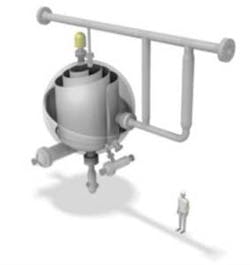P.2 ~ Compact separation technology enhances subsea boosting
View Article as Single page
Further subsea qualification under realistic conditions of a multi-phase flow loop with high flow capacity of up to 50,000 b/d of liquids at pressures up to 45 barg, was done for three different crude oils in the 19° to 36° API range.
In general the technology qualification method used can be divided into four main phases:
Phase 1. Computer modeling/system design: CFD simulations of flow phenomena form the basis for understanding of separation mechanism and design correlations.
Phase 2. Small scale model fluid tests: Measuring and visualizing physical flow phenomena (high-speed video) to verify the validity of Phase 1.
Phase 3. Large scale model fluid tests: To validate the design correlations to larger scale applications
Phase 4. Real scale tests under realistic conditions: High pressure, realistic scale flow rates and full hydrocarbon tests to verify the validity of design correlations and proper operation under field conditions.
To verify the performance and efficiency of various separation technologies, it is important to qualify the relevant equipment under realistic conditions of flow rate, pressures, and temperatures) at larger scale (up to 1:2 scale preferable).
Inline technology implementation
The robustness of the dual-stage inline separator is proven in operations for topsides applications, with more than three years of operation on an onshore wellhead platform, with the dual-stage inline separator as the single gas/liquid separation equipment used [lmaduddin, 2013].
Even though both vessel-based as well as inline separators are qualified and verified for subsea applications, further improvements in complexity and field economics are possible. A technology development program is ongoing as a joint industry project engaging several oil majors as well as a system integrator, to qualify a spherical separator mainly for deepwater applications.
Especially for deepwater developments, conventional solutions using cylindrical separator vessels are not feasible. This relates to vessel wall thickness requirements that limit vessel diameters [Olson, 2014]. If pipe code can be allowed for the design and fabrication, then this type of compact separation equipment can be considered.
To generalize, this latter type of solutions can be the most viable option from 1,500 m (4,920 ft) water depth. However compact systems will be sensitive to upset processing conditions and have complex controls. Installation costs can also be considerable.
In contrast, a spherical separator allows for a reduced wall thickness compared to cylindrical vessels and hence reduced fabrication costs and also reduced module size because of the more compact design. The use of a spherical separator allows for higher robustness and can substitute most of the compact equipment to simplify the whole solution and control system.
Spherical separators for high-pressure applications subsea have not been used or qualified. There is an ongoing joint industry project with oil companies and a system integrator participating that aims to qualify this solution for both gas/liquid separation as well as oil/water separation, as this is evaluated as a gap in the technology readiness level. The spherical separator can also be used as a slug catcher. In the first phase of the JIP a large-scale half-transparent spherical separator is going to be used for gas/liquid separation testing at low pressures. Future development will cover the oil/water testing, prior to a realistic conditions qualification program using a high pressure flow loop. Current planning calls for full qualification to be finalized by the end of 2016.
This would enable the spherical separator to be used in field developments from 2017 and compete with other qualified technology such as slender type gravity separators for shallow water and compact (inline) systems for deepwater fields.
Acknowledgment
Based on a paper presented at the Deep Offshore Technology International Conference & Exhibition held in Aberdeen, Scotland, Oct. 14-16, 2014.
References
Schook, R., Thierens, D., "De-bottlenecking of mature field production through the use of very compact and efficient separation equipment, topside or subsea," OTC-21617-PP, 2011.
lmaduddin, I; Tienhaara, M., "Compact processing solution: lnline gas-liquid separator on the Santos Wortel Field," SPE 166572, 2013.
Olson, M.D. et al, "Qualification of a Subsea Separator with On-line Desanding Capabilities for Shallow-water Applications," OTC-25367-MS, 2014.

